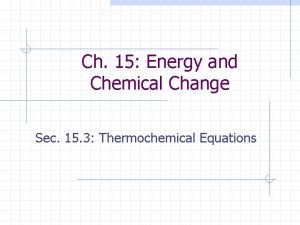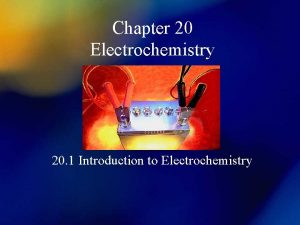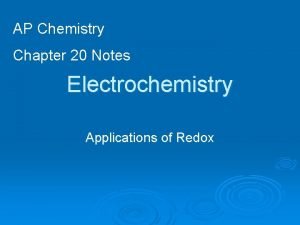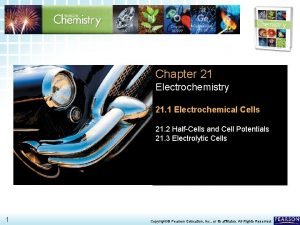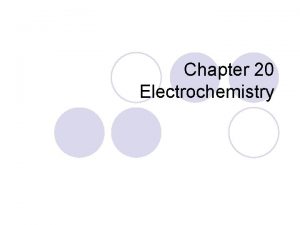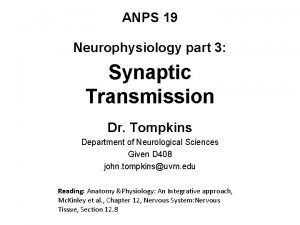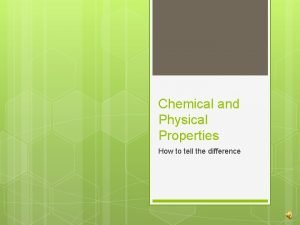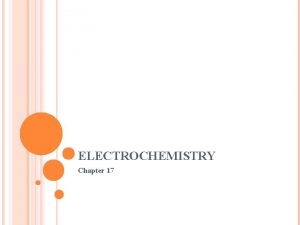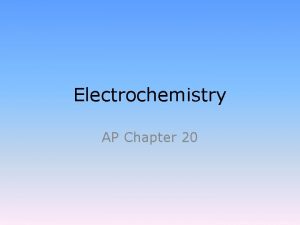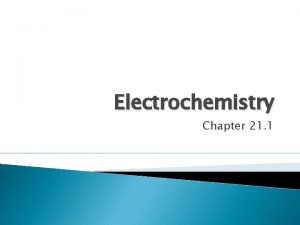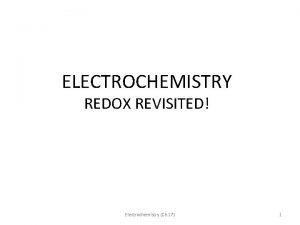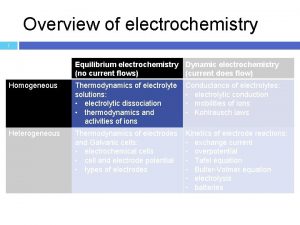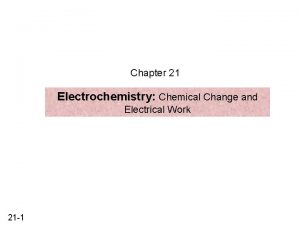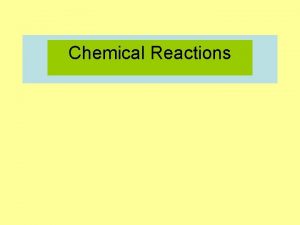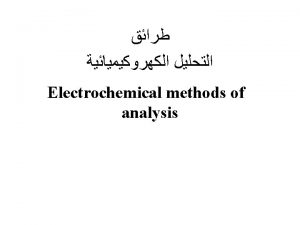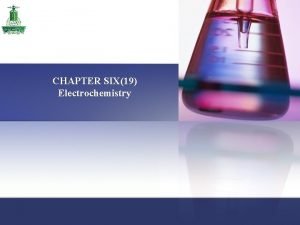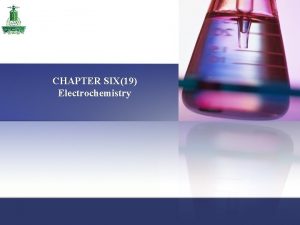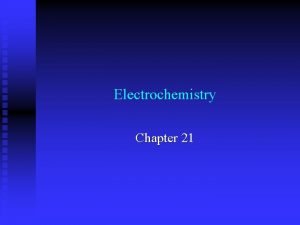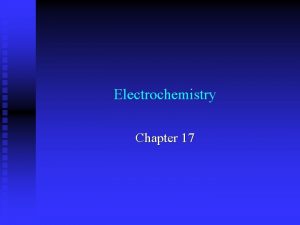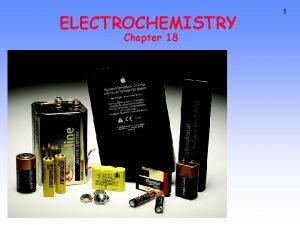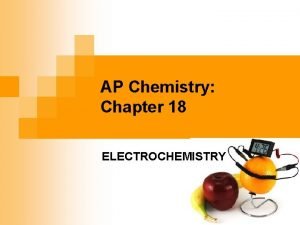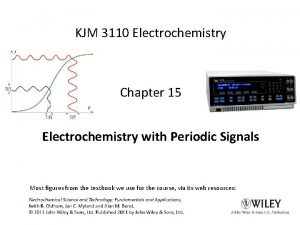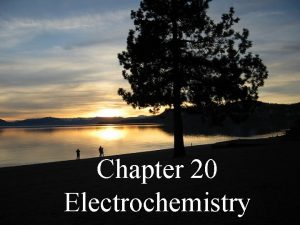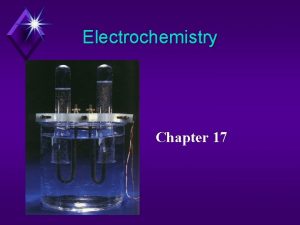Chapter 21 Electrochemistry II Chemical Change and Electrical






















![Using the Nernst Equation to Calculate Ecell Calculating Q: 2+] (P )[Zn (0. 30)(0. Using the Nernst Equation to Calculate Ecell Calculating Q: 2+] (P )[Zn (0. 30)(0.](https://slidetodoc.com/presentation_image_h/14b4e5e35083471958142a14de5ebbab/image-23.jpg)




- Slides: 27

Chapter 21: Electrochemistry II Chemical Change and Electrical Work 21. 3 Cell Potential: Output of a Voltaic Cell 21. 4 Free Energy and Electrical Work

Cell EMF Standard Reduction Potentials • The larger the difference between E red values, the larger E cell. • In a voltaic (galvanic) cell (spontaneous) E red(cathode) is more positive than E red(anode). • Recall E cell = E red(cathode) - E red(anode)

Standard Electrode (Half-Cell) Potentials Eo A standard electrode potential always refers to the half-reaction written as a reduction: Oxidized form + n e- reduced form Reversing a reaction changes the sign of the potential: Reduced form oxidized form + n e. For the zinc-copper reaction: Zn 2+(aq) + 2 e. Zn(s) Cu 2+(aq) + 2 e. Cu(s) Eohalf-cell - Eohalf-cell Eozinc (Eoanode ) [reduction] Eocopper(Eocathode ) [reduction]

Standard Electrode (Half-Cell) Potentials Eo Since the overall cell reaction involves the oxidation of zinc, we reverse the Zn reaction, and change the sign to get the cell potential: Zn(s) Cu 2+(aq) + 2 e- Zn 2+(aq) + 2 e. Cu(s) -Eozinc(-Eoanode) [oxidation] Eocopper(-Eocathode) [reduction] The overall redox reaction is the sum of these two: Zn(s) + Cu 2+(aq) Zn 2+(aq) + Cu(s) Eocell = Eocopper + (- Eozinc) = Eocopper - Eozinc E 0 cell = Eocathode - Eoanode

Determining an Unknown E°half-cell with the Standard Reference (hydrogen) Electrode Fig. 21. 7

(p. 911)

Using Standard Potentials: Cell EMF Oxidizing and Reducing Agents • The more positive E red the stronger the oxidizing agent on the left. • The more negative E red the stronger the reducing agent on the right. • A species on the higher to the left of the table of standard reduction potentials will spontaneously oxidize a species that is lower to the right in the table. • That is, F 2 will oxidize H 2 or Li; Ni 2+ will oxidize Al(s). • Any species on the right will spontaneously reduce anything that is higher to the left in the series.

Using Standard Potentials: Cell EMF Oxidizing and Reducing Agents

Relative Reactivities of Metals Which metals can displace H 2 from acid? The standard hydrogen half-reaction represents the reduction of H+ from acids to form molecular hydrogen, H 2: 2 H+(aq) + 2 e- H 2 (g) Eo = 0. 00 V The metals Li through Pb lie below hydrogen in the electromotive series Table 21. 2 (P 911). These will give a positive Eocell when reducing H+. For example iron: Fe(s) 2 H+(aq) + 2 e. Fe(s) + 2 H+(aq) Fe 2+(aq) + 2 e. H 2 (g) -Eo = 0. 44 V [oxidation] Eo = 0. 00 V [reduction] H 2 (g) + Fe 2+(aq) Eocell = 0. 44 V If Eocell of metal A for the reduction of H+ is more positive than Eocell of metal B, metal A is a stronger reducing agent than metal B. A is more reactive than B and is a more “active” metal.

Relative Reactivities of Metals that cannot displace H 2 from acid. The coinage metals [Group 1 B(11)]–Cu, Ag, and Au–are not strong enough reducing agents to reduce H+ from acids: Ag(s) 2 H+(aq) + 2 e 2 Ag(s) + 2 H+(aq) Ag+(aq) + e. H 2 (g) 2 Ag+(aq) + H 2 (g) -Eo = - 0. 80 V Eo = 0. 00 V Eocell = - 0. 80 V If the Eocell is negative, the reaction is not spontaneous. The higher the metal in the table, the more negative is its Eocell, The lower its reducing strength, and the less active it is. Thus, gold is less active than silver, which is less active than copper.

Relative Reactivities of Metals that displace H 2 from water. MREs and a hot meal? . Metals active enough to displace H 2 from water lie below the half-reaction for the reduction of water: 2 H 2 O(l) + 2 e. H 2 (g) + 2 OH -(aq) Eo = - 0. 42 V Consider the reaction of sodium with water: 2 Na(s) 2 Na+(aq) + 2 e-Eo = 2. 71 V [oxidation] 2 H 2 O(l) + 2 e. H 2 (g) + 2 OH-(aq) Eo = - 0. 42 V [reduction] 2 Na(s) + 2 H 2 O(l) 2 Na+(aq) + H 2(g) + 2 OH -(aq) Eocell = 2. 29 V Metals that can displace other metals from solution. Metals below others in Table 21. 2, can replace them from solution: Zn(s) Fe 2+(aq) + 2 e- Zn 2+(aq) + 2 e. Fe(s) Zn(s) + Fe 2+(aq) Zn 2+(aq) + Fe(s) -Eo = 0. 76 V [oxidation] Eo = - 0. 44 V [reduction] Eocell = 0. 32 V

The Reaction of Calcium in Water Fig. 21. 8

(p. 915)

A. Any one of these thermodynamic parameters can be used to find the other two. B. The signs of Go and Eocell determine the reaction direction at standard-state conditions. Fig. 21. 9

Comparison of Voltaic and Electrolytic Cells Electrode Cell Type G Ecell Name Process Voltaic <0 >0 Anode Oxidation - Voltaic <0 >0 Cathode Reduction + Electrolytic >0 <0 Anode Oxidation + Electrolytic >0 <0 Cathode Reduction - Table 21. 4 (p. 932) Sign

Spontaneity of Redox Reactions EMF and Free-Energy Change • We can show that G = -n. FE • G is the change in free-energy, n is the number of moles of electrons transferred, F is Faraday’s constant, and E is the emf of the cell. • We define • C = Coulomb, the charge of 6. 242 x 1018 electrons • V = Volt (the electric potential) • Since n and F are positive, if G > 0 then E < 0.

Effect of Concentration on Cell EMF • A voltaic cell is functional until E = 0 at which point equilibrium has been reached. • The point at which E = 0 is determined by the concentrations of the species involved in the redox reaction. The Nernst Equation • The Nernst equation relates emf to concentration using and noting that

Effect of Concentration on Cell EMF The Nernst Equation • This rearranges to give the Nernst equation: • The Nernst equation can be simplified by collecting all the constants together using a temperature of 298 K: • (Note that change from natural logarithm to base-10 log. ) • Remember that n is number of moles of electrons.

Calculating K and Go from Eocell Problem: Lead can displace silver from solution: Pb(s) + 2 Ag+(aq) Pb 2+(aq) + 2 Ag(s) As a consequence, silver is a valuable by-product in the industrial extraction of lead from its ore. Calculate K and Go at 25 o. C for this reaction. First calculate Eocell and then substitute the valueto find K and Go. Solution: Writing the half-reactions and their Eo values: (1) Ag+(aq) + e. Ag(s) Eo = 0. 80 V (2) Pb 2+(aq) + 2 e. Pb(s) Eo = - 0. 13 V Calculating Eocell: We double (1), reverse (2), and add the half-reactions: 2 Ag+(aq) + 2 e 2 Ag(s) Eo = 0. 80 V Pb(s) Pb 2+(aq) + 2 e-Eo = 0. 13 V Pb(s) + 2 Ag+(aq) Pb 2+(aq) + 2 Ag(s) Eocell = 0. 93 V

Calculating K and Go from Eocell Calculating K: the adjusted half reactions show that 2 mol e- are transferred per mole of reactant as written, so n = 2: Eocell = 0. 0592 V log K = n 0. 0592 V log K = 0. 93 V 2 log K = (0. 93 V)(2)= 31. 42 0. 0592 V so, and K = 2. 6 x 1031 Calculating Go : Go = - n. FEocell 2 mol e = x mol rxn Go = - 1. 8 x 102 k. J/mol rxn 96. 5 k. J x 0. 93 V V. mol e-

Summary: The Effect of Concentration on Cell Potential Ecell = Eocell - RT ln Q n. F Ecell = Eocell - 0. 0592 V log Q n (at 25 o. C) When Q < 1; [reactant] > [product], ln Q < 0, so Ecell > Eocell When Q = 1; [reactant] = [product], ln Q = 0, so Ecell = Eocell When Q > 1; [reactant] < [product], ln Q > 0, so Ecell < Eocell

Using the Nernst Equation to Calculate Ecell Problem: In a test of a new reference electrode, a chemist constructs a voltaic cell consisting of a Zn/Zn 2+ electrode and the H 2/H+ electrode under the following conditions: [Zn 2+] = 0. 010 M [H+] = 2. 5 M PH 2 = 0. 30 atm Calculate Ecell at 25 o. C. Plan: Find Eocell and Q: 1) write the spontaneous reaction, 2) calculate Eocell from standard electrode potentials (Table 21. 2), 3) use the given pressure and concentrations to find Q. Solution: Determining the cell reaction and Eocell: 2 H+(aq) + 2 e. Zn(s) H 2 (g) Zn 2+(aq) + 2 e- Eo = 0. 00 V -Eo = 0. 76 V 2 H+(aq) + Zn(s) H 2 (g) + Zn 2+(aq) Ecell = 0. 76 V
![Using the Nernst Equation to Calculate Ecell Calculating Q 2 P Zn 0 300 Using the Nernst Equation to Calculate Ecell Calculating Q: 2+] (P )[Zn (0. 30)(0.](https://slidetodoc.com/presentation_image_h/14b4e5e35083471958142a14de5ebbab/image-23.jpg)
Using the Nernst Equation to Calculate Ecell Calculating Q: 2+] (P )[Zn (0. 30)(0. 010)= 4. 8 x 10 -4 H 2 Q= = [H+]2 (2. 5)2 Solving for Ecell at 25 o. C (298 K), with n = 2: Ecell = Eocell - 0. 0592 V log Q = 0. 76 V - 0. 0592 V log (4. 8 x 10 -4 n 2 Ecell = 0. 76 V - (-0. 098 V) = 0. 86 V

The Relation Between Ecell and Log Q for the Zinc-Copper Cell Fig. 21. 10

How a Concentration Cell Works In a concentration cell, the half-reactions are the same but the concentrations are different. Because of this, the nonstandard cell potential, Ecell, is nonzero because it depends upon the ratio of ion concentrations. In Fig 21. 11 A we see a system with 0. 10 M Cu 2+ in the anode half-cell and 1. 0 M Cu 2+, a 10 -fold higher concentration, in the cathode half-cell. Cu(s) Cu 2+(aq, 0. 10 M) + 2 e[anode; oxidation] Cu 2+(aq, 1. 0 M) + 2 e. Cu(s) [cathode; reduction] Cu 2+(aq, 1. 0 M) Cu 2+(aq, 0. 10 M) Ecell = ? Using the Nernst equation, and n = 2, we get: 2+] 0. 0592 V [Cu o dil = 0 V - 0. 0592 V log 0. 10 M Ecell = E cell log 2 [Cu 2+]conc 2 1. 0 M Ecell = 0 V - 0. 0592 V (-1. 00) = + 0. 0296 V 2

A Concentration Cell Based on the Cu/Cu 2+ Half-Reaction Fig. 21. 11

The Laboratory Measurement of p. H Fig. 21. 12
 Chemical and physical changes
Chemical and physical changes Difference between chemical and physical property
Difference between chemical and physical property What is example of physical change
What is example of physical change Whats the difference between physical and chemical change
Whats the difference between physical and chemical change Is cutting paper a physical change
Is cutting paper a physical change Spare change physical versus chemical change
Spare change physical versus chemical change When does a physical change occur study jams
When does a physical change occur study jams Chemical changes in baking
Chemical changes in baking Physical change chopping wood
Physical change chopping wood Empirical formula and molecular formula pogil
Empirical formula and molecular formula pogil What is the chemical formula for tetranitrogen heptoxide?
What is the chemical formula for tetranitrogen heptoxide? Chapter 15 energy and chemical change
Chapter 15 energy and chemical change Ap chemistry chapter 18 electrochemistry test
Ap chemistry chapter 18 electrochemistry test Chapter 20 electrochemistry
Chapter 20 electrochemistry Ap chem electrochemistry review
Ap chem electrochemistry review Cell chapter 21
Cell chapter 21 Electrolysis vs voltaic cell
Electrolysis vs voltaic cell Electrons flow from anode to cathode
Electrons flow from anode to cathode Example of
Example of Are kc and kp equal
Are kc and kp equal Chemical synapses
Chemical synapses Chapter 9 chemical names and formulas chapter quiz answers
Chapter 9 chemical names and formulas chapter quiz answers Physical and chemical change grade 10
Physical and chemical change grade 10 Whats the difference between chemical and physical change
Whats the difference between chemical and physical change Mixing red and green marbles physical or chemical change
Mixing red and green marbles physical or chemical change Differentiate between physical and chemical change
Differentiate between physical and chemical change Styrofoam and acetone chemical or physical change
Styrofoam and acetone chemical or physical change Class 7 chemical and physical change
Class 7 chemical and physical change











